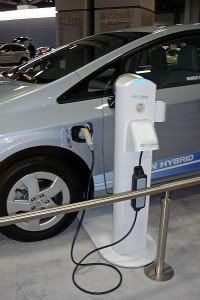I’m in New York City this week, doing a consulting project for 2GreenEnergy client Doty Windfuels. I knew going in that this was going to be interesting, but there was no way I could have predicted the drama.
Windfuels is one of 75 companies “pitching” its business concept to a large group of venture capitalists. Each entrepreneur has a highly refined PowerPoint deck, and uses carefully chosen works to describe his “baby,” in the hopes of landing a workable relationship with a VC partner. All of these 75 have some merit, it seems to me; in fact the group was screened, eliminating those whose ideas clearly didn’t merit further attention.
Yet the evaluation of a business idea is clearly a bit subjective; some people have an understanding of a certain type of technology, an appetite for a certain type of risk, etc. Yet VC’s have little compunction about telling entrepreneurs that their baby is ugly. In a session yesterday, someone responded to the Windfuels concept, “I don’t doubt the science, but I don’t see the business case.”
I, for one, can see that, after a development period of 2 – 3 years, Windfuels is a very good bet to be able to demonstrate a pilot plant in which high-grade fuel is being produced from energy, water, and CO2, using processes that can be expected to scale, making the price competitive with oil at $55 a barrel. That doesn’t have value? Imagine you’re an ExxonMobil or a Chevron, you’re running out of oil to extract, and your costs are rising. At the same time, you’re trying to convince the world that you’re not an oil company; you’re an “energy company.” You visit a facility where your product is being made cost-effectively without a molecule of crude. Sounds pretty appealing to me.
Fortunately, some people really “get it” when it comes to the concept, and see that the world’s first workable approach to synthetic fuels has potential that dwarfs literally every other idea here. We’re talking about a trillion dollar market; this is not a better approach to spear fishing, or something like that.
Well, today is another day, and a new set of VCs. It only takes one. And, in truth, Windfuels is a better fit for a different type of investor anyway; I’m going to try to find them someone who may be more appropriate. Let’s see what happens.




 The Mellman Group for Ceres conducted a poll of likely Michigan and Ohio voters, and found that the voters overwhelmingly supported an increase to average fuel economy standards to 60 miles per gallon by 2025.
The Mellman Group for Ceres conducted a poll of likely Michigan and Ohio voters, and found that the voters overwhelmingly supported an increase to average fuel economy standards to 60 miles per gallon by 2025.

![[The Vector] Venture Capital Investment Increases Substantially into Green Energy](/wp-content/uploads/2011/06/pew-2004-to-2010-chart-global-investments.jpg)
